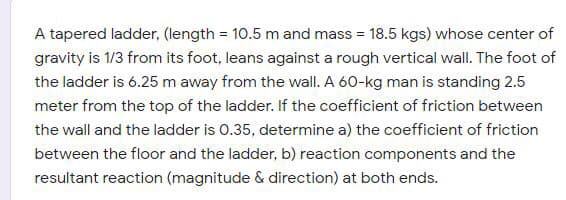A tapered ladder, (length = 10.5 m and mass = 18.5 kgs) whose center of gravity is 1/3 from its foot, leans against a rough vertical wall. The foot o the ladder is 6.25 m away from the wall. A 60-kg man is standing 2.5 meter from the top of the ladder. If the coefficient of friction between the wall and the ladder is 0.35, determine a) the coefficient of friction between the floor and the ladder, b) reaction components and the resultant reaction (magnitude & direction) at both ends.
A tapered ladder, (length = 10.5 m and mass = 18.5 kgs) whose center of gravity is 1/3 from its foot, leans against a rough vertical wall. The foot o the ladder is 6.25 m away from the wall. A 60-kg man is standing 2.5 meter from the top of the ladder. If the coefficient of friction between the wall and the ladder is 0.35, determine a) the coefficient of friction between the floor and the ladder, b) reaction components and the resultant reaction (magnitude & direction) at both ends.
International Edition---engineering Mechanics: Statics, 4th Edition
4th Edition
ISBN:9781305501607
Author:Andrew Pytel And Jaan Kiusalaas
Publisher:Andrew Pytel And Jaan Kiusalaas
Chapter7: Dry Friction
Section: Chapter Questions
Problem 7.3P: Two identical chairs, each weighing 14 lb, are stacked as shown. The center of gravity of each chair...
Related questions
Question
Kindly show the FREE BODY DIAGRAM and include the derivation of Summation X and Y (if possible). Always equate the equation to zero since it's equilibrium. Thanks in advance

Transcribed Image Text:A tapered ladder, (length = 10.5 m and mass = 18.5 kgs) whose center of
gravity is 1/3 from its foot, leans against a rough vertical wall. The foot of
the ladder is 6.25 m away from the wall. A 60-kg man is standing 2.5
meter from the top of the ladder. If the coefficient of friction between
the wall and the ladder is 0.35, determine a) the coefficient of friction
between the floor and the ladder, b) reaction components and the
resultant reaction (magnitude & direction) at both ends.
Expert Solution
This question has been solved!
Explore an expertly crafted, step-by-step solution for a thorough understanding of key concepts.
This is a popular solution!
Trending now
This is a popular solution!
Step by step
Solved in 2 steps with 1 images

Knowledge Booster
Learn more about
Need a deep-dive on the concept behind this application? Look no further. Learn more about this topic, mechanical-engineering and related others by exploring similar questions and additional content below.Recommended textbooks for you

International Edition---engineering Mechanics: St…
Mechanical Engineering
ISBN:
9781305501607
Author:
Andrew Pytel And Jaan Kiusalaas
Publisher:
CENGAGE L

International Edition---engineering Mechanics: St…
Mechanical Engineering
ISBN:
9781305501607
Author:
Andrew Pytel And Jaan Kiusalaas
Publisher:
CENGAGE L